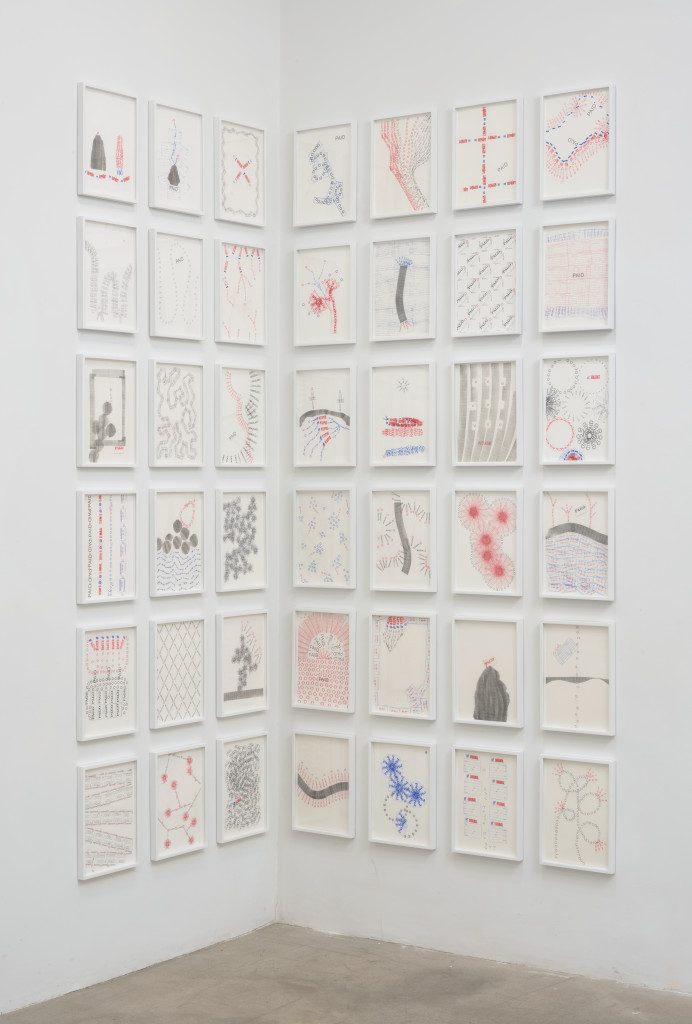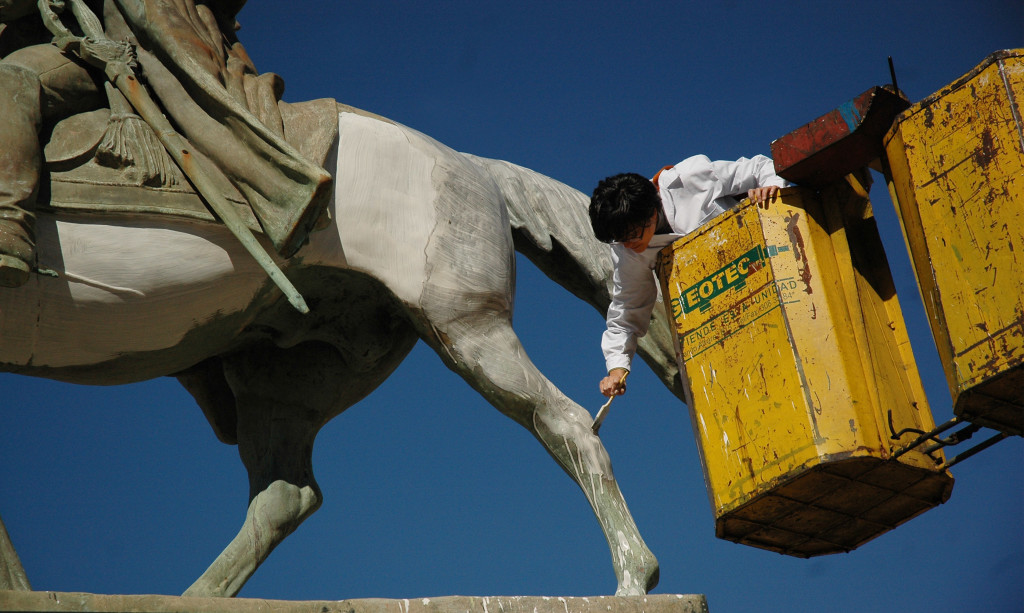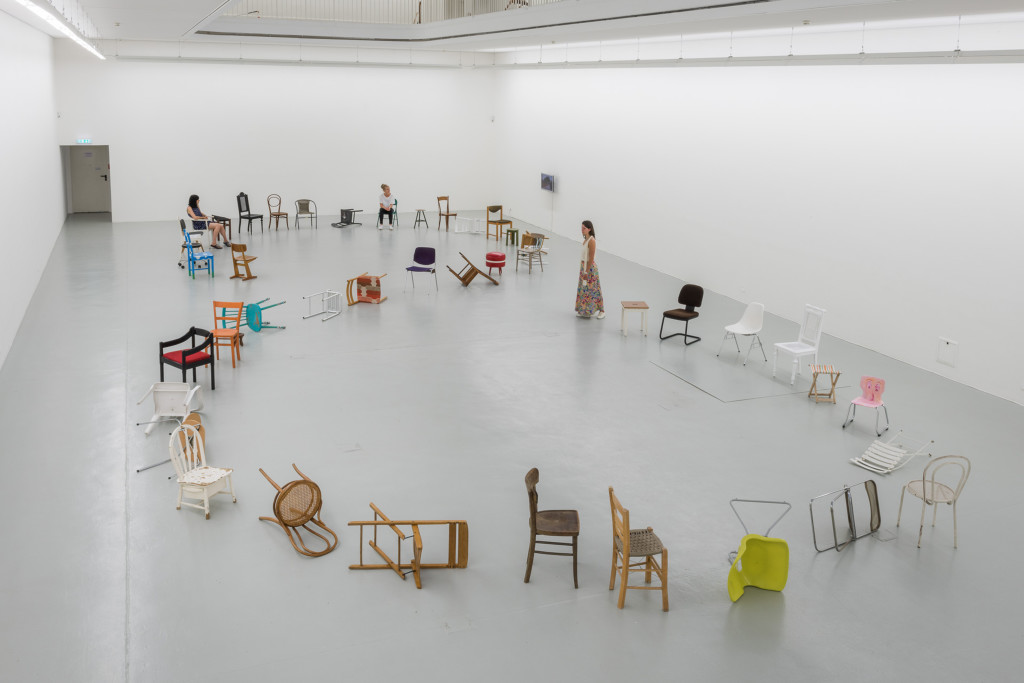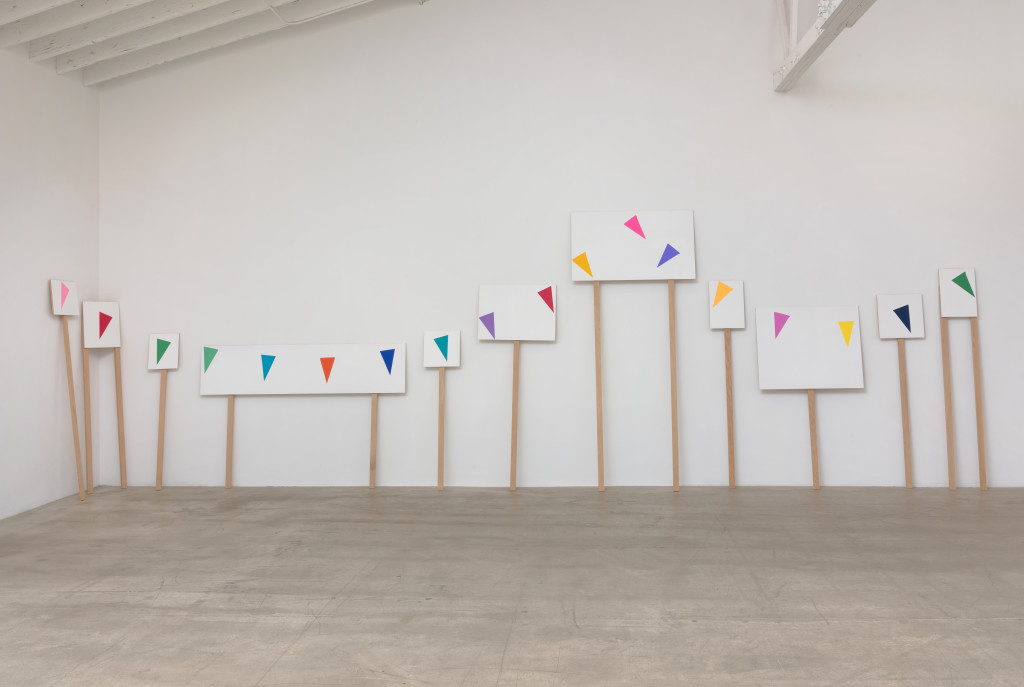Amalia Pica: The Experience of Strangers
by Ionit Behar

London-based Argentinian artist Amalia Pica focuses her work on the problem of communication: our performative nature of thought and speech. Pica’s wide-ranging practice includes sculpture, photography, drawing, film, installation, and performance. Her work often alludes to communal experiences, especially those we share with strangers—either at a party, a public square, or a museum. Pica in London and myself in Chicago, six hours apart and many miles away, met for the first time via Skype, adding another layer to our conversation about strangers communicating. A transcription of the conversation is below.
Ionit Behar: Your work is very much about communication and relationships between people—strangers or acquaintances. What is it about communication that mostly interests you? What drove you to focus on this aspect of life and art?
Amalia Pica: I think it all began from an intrinsically artistic question, which is the question, or sets of questions, that we inherited from the 1960s and 70s: is there such a thing as visual language? What are the possible relationships between art and language? Are there images that function as words? I was always very interested in this—if art was language, or if there is a relationship between art and language, then there is something to be understood. The possibility of understanding artworks is a bit problematic in the sense that you would be asking your audience to decode something. The message in art making is never so straightforward, so I slowly became more intrigued by the idea of enunciation, and how you did not think everything beforehand. In other words, when you talk with someone else, you usually come up with what you are thinking, at the same that you are talking aloud—so, in a sense, speaking is thought being performed. I like to approach my art making in a similar way.
IB: How does the dictatorship in Argentina and its aftermaths influence your work? In multiple artworks you reference the dictatorship and its repression.
AP: I felt the impact of the dictatorship through my family. My parents exiled to Patagonia because they got into trouble. One of the things that I realize, which is not an international concept, is the idea that there is a social or political responsibility of being an artist. This was very prevalent in the National School of Visual Arts in Buenos Aires, but the school had a very academic approach. I was part of the Centro de Estudiantes and the Students’ Union then—we were fighting against the absorption of the art school into the University structure, which we did not think was the best thing to do. We took over the school for ninety days, and it was through these actions that we came in direct contactto other [artist collectives] and groups that were working with the aftermaths of the dictatorship, such as Grupo Etcétera or Grupo de Arte Callejero. At that time, I was still trying to understand my role as an artist within a political landscape, but I still had a desire to develop a more subjective or individual work.
IB: I am very interested in your interventions to public monuments and plazas. For example, in 2011 you painted the General San Martín Monument in Neuquén with a white solution made out of white chalk in commemoration of 30 years of democracy of Argentina.

AP: Actually, the first time I did this kind of project was in Montevideo in 2007 or 2008 with a statue of Bolivar. At that time, I had just finished art school and I was teaching primary school. As the art teacher you are asked to do all the sets for the school plays, so for a couple of years I was the person that was drawing the Independence House or other national monuments. I just realized that I was participating in this machine that repeats historical images in a non-critical way. I became aware that the transmission of memory—especially in Argentina and Latin America—is created by these public monuments. In my mind, I was enacting a sort of school teacher that was correcting the monuments and trying to unveil them. I wanted to be that teacher that encourages you how to re-read history, how to re-draw and re-write monuments.
IB: When you use party objects, such as fiesta lights, banners, confetti, and drinking glasses, are you trying to bring joy and play to the museum? I read somewhere that your favorite activity is dancing!
AP: My obsession with communication is trying to find things that people would recognize by themselves. What I like about celebratory objects, is that they are almost indexes of how you are allowed to behave or feel. So in a sense, yes, there is an irreverence to try to bring this attitude and relaxation into the museum, but also because I think these sort of celebrations are very useful metaphors. What I like about a street party or carnival is that it is a good-happy time that you share with strangers. It is beautiful to be able to do that with people that you do not know. I think it is easy to imagine how the world could be better if you live with people that you love, but there are a lot of people that we live with that we do not know and we do not have reasons to love. So in a sense, these celebrations are a metaphor of cultural intimacy or social space that you can share with strangers in a positive way. While I am interested in being critical and analytical, I do not want to make art that is always constructed in opposition of an argument. It is important to try to find positive, affirmative, happy moods or reasons to make art.

IB: In some of you works, I see connections with other iconic Argentinean artworks such as Oscar Bony’s La Familia Obrera (1968) and Marta Minujin’s La Menesunda (1965). Do you see that as well?
AP: These artists that you name have a built a vocabulary and my generation is using it. La Menesunda is a great example of an artwork that is about communication, social intimacy, and celebration. It was very influential not only to me but to a whole generation of artists. Of course, Bony’s La Familia Obrera is a work that is much more provocative and problematic, because it deals with real life in a different way. It steps out of being fictional. I have not thought about this specific piece in relationship to my Stage (as seen on Afghan Star), for example, but I can relate our practices in the sense that my work offers a platform to people—when you offer a platform in a museum, people play a version themselves. The balance of paying a family to be there, as Bony did, or the possibility of offering this platform to a family to play themselves is different. Though, it is only because of artists like him that we do these other things.
IB: Your more recent body of work deals with bureaucracy and its materiality. How does this project relate to your experiences as an immigrant?
AP: Bureaucracy is such a big part of becoming a grown up, and it is such an oppressive thing. While I was recently naturalized British, I had been in Europe for over twelve years with a South American passport. The Joy in Paperwork series (2016) was completely related to me trying to gain British nationality, and not being able to travel—while I had my home in the UK, it was not easy for me to get the documents I needed to travel for work. When my first application was rejected, a lawyer suggested that I stay put and not travel. There is all this talk about digitization of everything, but you still travel with a passport and you get stamps, so each time I would deliver a lecture in Europe, I would get stamped and it would be counted against me. It was through these stamps that I had basically gotten into trouble, so I decided to not travel and instead ask my friends to send me stamps from where they were going. In a private and personal way, I was trying to inject joy in these processes which are so overwhelming, scary, and frustrating. I instead went back to those childhood moments where you play with stamps—my mother is a doctor, so I played with her stamps. In this project, I tried out the possible relation between joy and suppression, or whether happiness can be a revolutionary act, even on an intimate scale.
IB: I am curious about your titles, especially the choice for the series Catachresis, for example Catachresis #8 (head of the nail, teeth of the comb, eye of the needle, head of the screw) (2011). Your titles seem point to your interest in language and its mechanisms.

AP: I often feel that the title of a work functions as this little bit in which you can insert text, and give [the viewer] a pointer. In the case of Catachresis, the title of the series references terms given to many different types of figures of speech, in which a word or phrase is being applied in a way that significantly departs from traditional usage. For example, we call the legs of a table legs, even though they are not human or animal, because we do not know what else to call them. I started to collect objects that were named with words from the human body, such as the eye of a needle, the head of broccoli, elbow of a pipe, the tongue of a shoe. Then language would be the absurd meeting point where these objects became sculptures. My whole interest with communication is because I have a sort of childish desire to be understood, and I want people to understand what I am saying—from there, they can take their own conclusions.
Amalia Pica (b. 1978, Neuquén, Argentina) studied sculpture at the National School of Visual Arts in Buenos Aires and completed a two year residency at the Rijksakademie van Beeldende Kunsten. Her work has been shown at important institutions including one person exhibitions at Kunstverein Freiburg, Freiburg (2016); Portlligat, El Nuevo Museo de Arte Contemporáneo, Ciudad de Guatemala, Guatemala (2015); Instituto de Visió, Bogota (2015); KÖNIG GALERIE, Berlin (2015); Van Abbemuseum, Amsterdam (2014); Museo Nacional de Bellas Artes, Neuquén (2013); Museum of Contemporary Art Chicago (2013); List Visual Arts Center, Cambridge (2013); and Kunsthalle Sankt Gallen, Gallen (2012). In 2017, upcoming solo exhibitions include The Power Plant, Toronto; the Institute of Modern Art, Brisbane; NC Arte Bogotá, as well as group exhibitions at S.M.A.K, Ghent; The Drawing Room, London; Netwerk Center for Contemporary Art, Aalst; FRAC Lorraine, Metz, and more. Pica currently lives and works in London and Mexico City.